
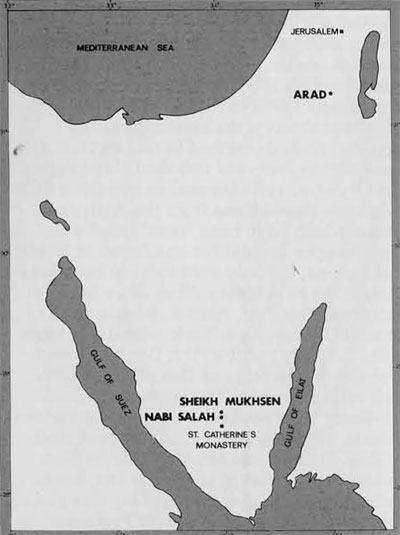
During the past ten years, Israeli archaeologists have been investigating early sites which have been discovered in the wilderness of the Sinai Peninsula. We have learned from the archaeological evidence that the lofty magmatic mountain region of southern Sinai, which reaches a height of approximately 2,500 m. above sea level, was inhabited primarily during the prehistoric periods (7th-4th millenniums B.C.), the Early Bronze Age and the Byzantine period. Many of these studies have been carried out by the Tel Aviv University Institute of Archaeology’s Ophir Expedition to Sinai under my direction.
Since 1971, the expedition has been studying early settlements within which pottery was discovered. These settlements are located in the valleys of the highest mountain region in southern Sinai, approximately 10 to 20 miles north of St. Catherine’s Monastery. In the course of these studies, five sites were excavated and an archaeological survey of an area of approximately 150 sq. km. in their environs was made. This work proved that the settlements were established in Early Bronze Age II in the first half of the third millennium B.C. Their culture was the same Canaanite culture found in occupation levels in sites in Palestine, principally Strata I-III at Arad which at that time was a fortified town, the largest known thus far in southern Palestine.
Here we shall briefly describe the results of the excavations carried out on such a site discovered by the Ophir Expedition near the tomb of Sheikh Mukhsen, approximately 20 km. north of St. Catherine’s Monastery. It is located on a broad terrace on the northern bank of Wadi Mukhsen and extends over an area of approximately 2.5 acres. Four domestic units (A-D) were found and excavated; an additional unit (F) located at a distance of 300 m. from the central site was also excavated.
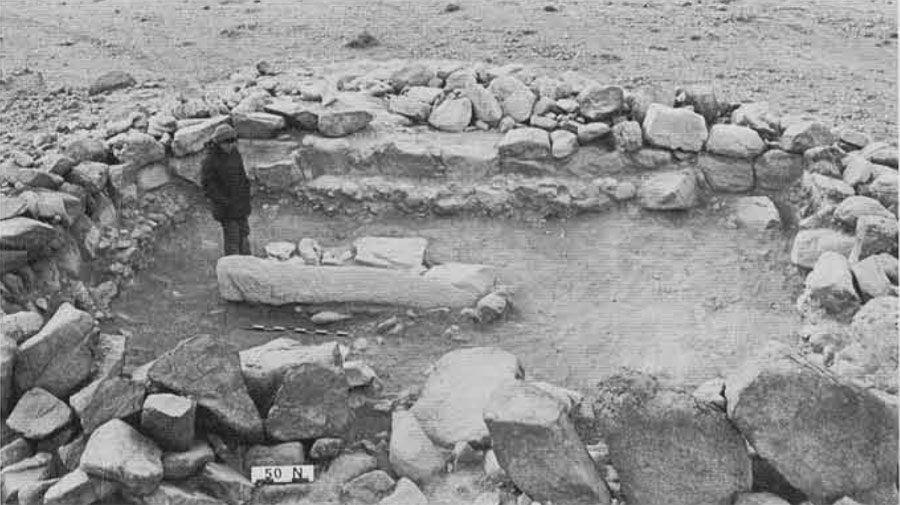
The Architecture
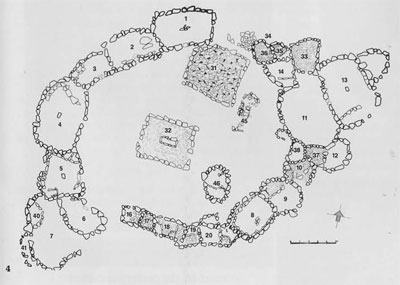

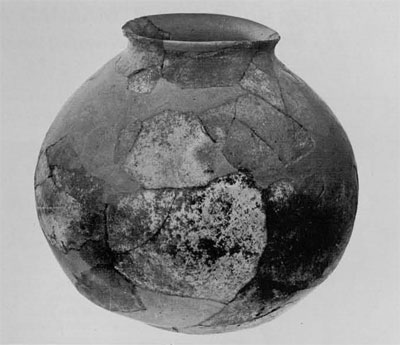
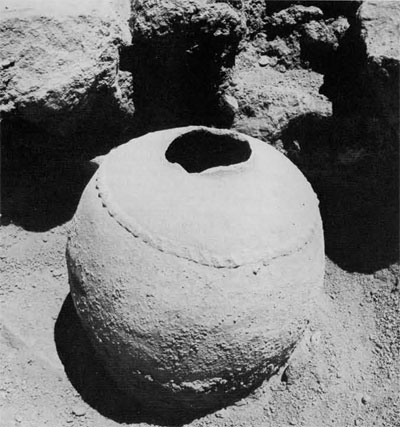
These units comprised dwellings and work and storage rooms attached to each other in the form of a ring which surrounded a large round or oval courtyard. The largest unit (A) comprised 8 rooms serving as living quarters and about 10 small chambers which surrounded an oval courtyard with a long diameter of 22 m. and two entrances, on the south and the north. Two rectangular tumuli (31,32) were built in it in a later period.
The living quarters were of the kind designated as “broad rooms,” which have a rectangular shape and rounded corners. Their average size is 5 x 3 m. with an entrance in the long wall facing the central courtyard. These structures were built of local granite found in abundance around the site. The level of the floors in the living quarters was about 40 cm. lower than the surrounding level. On both sides of the entrance stood monoliths approximately 80 cm. high, and between them was a flat stone threshold. Inside the room there were one or two steps and in one of the rooms (Room 5) there was a doorsocket to the left of the entrance. In most of the rooms there were benches attached to the walls and in the corners were low compartments. Opposite the entrance, in the middle of the room, was a flat stone which apparently served as a base for a wooden pillar which supported the roof. But in the center of one of the rooms (Room 50), an entire monolith, 2.52 m. long, was discovered lying on the floor with its base implanted in situ. In every room, the remains of a hearth were found to the left of the entrance.
The small chambers were round or square with partitions within. The level was that of the surrounding area or even. higher. Many were floored with stone slabs. Their walls, as the small amount of rubble testifies, were probably very low and no entrances were found in them.
The living quarters were built by the simple method of laying down areas of foundation stones within a shallow hole that was dug prior to laying the stones, and afterwards the building was done according to the polygonal method, with the stones laid dry without use of mortar.
It is noteworthy that both the method of construction and the design are typical of every domestic site we have excavated in southern Sinai.
From architectural remains preserved on the site as well as from additional objects found in the stone rubble, in combination with a “Theoretical Structure” of the collapsed walls which were found sealed in a layer of sand, it may be reckoned that the height of the walls of the living quarters reached approximately 1.75 m. and that the entrances were low (ca 80 cm.) and narrow (ca 55 cm.).
The ceilings of the rooms seem to have been made of light materials, such as animal hides or branches from trees, and were supported by wooden or stone pillars which were higher than the walls and made a steeply sloping roof. We should mention that there is a close architectural resemblance between these rooms and those in contemporary settlements in Israel, especially in Arad, a resemblance in both shape (“broad rooms”) and their low level, as well as in the objects found inside them.
The Finds
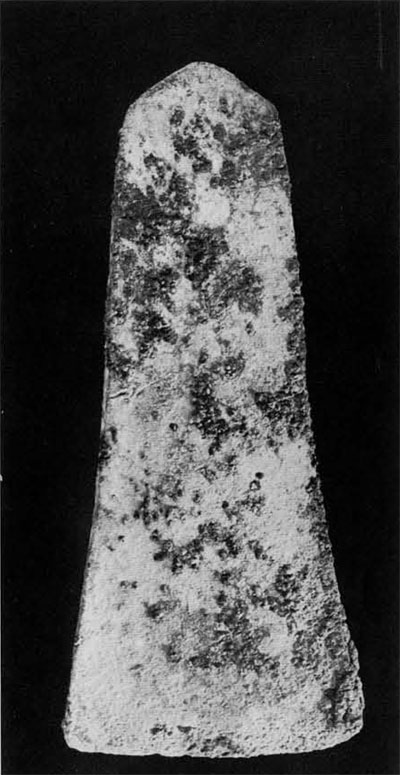
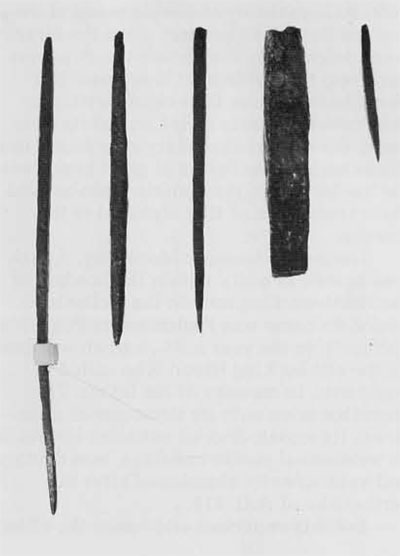
The finds were discovered on the surface of the site, but principally in the stratum of ashes upon the floors. They consisted mostly of pottery vessels, flint tools, and copper artifacts, pendant earrings and beads, conches, animal bones, and fragments of wood.
Almost all the pottery included Canaanite vessels which were widespread in Israel in Early Bronze Age II. The most numerous, often the only parallels, are from Canaanite Arad, Strata I-III, which date from this period. These vessels included hole-mouth jars, jugs and juglets some of which are red-burnished, bowls including platters and cup-bowls, and kraters. Petrographic tests of hole-mouth cooking pots from this site identical to those from Arad, show that the potsherds contain granitic material whose source is Sinai, a fact which demonstrates the close ties between the two places. The smallest percentage of ceramic ware was of Egyptian origin and comprised principally jars which were widespread in Egypt in the time of the First Dynasty. This agrees with other evidence indicating that the EB II period in Palestine was contemporary with the First Dynasty of Egypt.
In the living quarters and in the small chambers, there were copper artifacts including square-cut chisels and awls, as well as axes of a type widespread in Israel and in the whole Levant during this period. A few pieces of copper ore were also discovered, as well as slag, fragments of crucibles, and a lump of refined copper, indicating that the people were engaged in among other things, the production of copper from local mines located approximately 5 miles east of the site.
In a survey which we did in the region close to an early copper mine, we found work sites of this period; here the copper was extracted.
Conclusion
These work sites provide a definitive explanation for the existence of Canaanite settlements in a desert region as much as 300 miles from population centers in Palestine. There can be no doubt that only their eagerness for a location near so important a resource as copper could cause the migration of a large population over such a great distance with all its logistic and political implications.
It is worth noting that we have evidence during this period of a certain Egyptian presence in the south of the coastal plain of Palestine, a presence which a few scholars have attributed to Egyptian hegemony. However, the fact that this presence did not prevent a Canaanite population from southern Palestine spreading out to southern Sinai hints at economic co-existence between the two countries.
